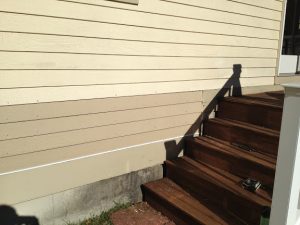Building Paper is commonly used in Masonry and Stucco Exterior Wall Finishes
By Mark J. Donovan
|
|
What is building paper and what is it used for is a common question for the average DIY homeowner? Building paper is thick tar paper that is frequently used between exterior wall sheathing and masonry / stucco siding. Building paper is also used for temporary home weather protection. Building paper comes in rolls of various widths, lengths and weights.
Building paper is commonly used in stucco and masonry applications to prevent water from contacting wood and metal surfaces that can rot and rust, respectively. |
In addition, due to the fact that wood can expand and contract with variations in humidity levels, building paper can help prevent stresses on the stucco and masonry walls.
By using building paper a separation layer is created between the stucco/masonry surface and the wall sheathing. This separation layer prevents water penetration and compensates for different coefficient rates of expansion between the wood sheathing and the masonry wall finishes.
| Building Paper Benefits
By preventing water penetration, wood expansion and contraction is dramatically reduced, and any wood expansion/ contraction that does occur is not transmitted to the masonry / stucco surfaces. As a result, building paper reduces the risks of masonry/stucco cracks. Many local building codes recommend the use of two layers of building paper for masonry/stucco applications, due to the fact that building paper can be easily damaged during the construction of the home. |

Get this ebook to learn how to patch wood siding. |
When applying building paper to exterior walls, or even roof sheathing if using tarred roof felt paper, it should be lapped similar to applying siding or shingles to a wall or roof.
For example the first course/layer of building paper should be applied to the lower level walls, or the bottom edge of the roof. The next course/layer that sits above the lower course/layer should be lapped over it by approximately 6 inches.
| For vinyl siding or wood clapboard siding, building paper such as Tyvek or Typar are commonly used today. They are lighter weight, wider, and easier to install than traditional tar based building paper. Tyvek and Typar house wraps are also more breathable than traditional building paper and roof felt, and have fewer seams.
So whether your home’s exterior walls are to be clapboard sided, vinyl sided or masonry side, make sure you use a building paper on the exterior wall sheathing. |
 |
Building paper will shield your home from both water and air infiltration, which in turn will protect your home from moisture damage and drafts.
Patching Wood Siding Ebook – If you require detailed instructions and pictures for patching wood siding see HomeAdditionPlus.com’s Patching Wood Siding Ebook. This Ebook provides very detailed instructions, along with pictures for each key step in the process of patching wood siding.
Related Information
Get Free Siding Price Quotes with No Obligation!
Fill out our 3-5 minute quick and easy form, and receive a free price quote on home siding from one of our prescreened and licensed siding contractors. This process is free and there is no obligation to continue once you receive your home siding estimate.
